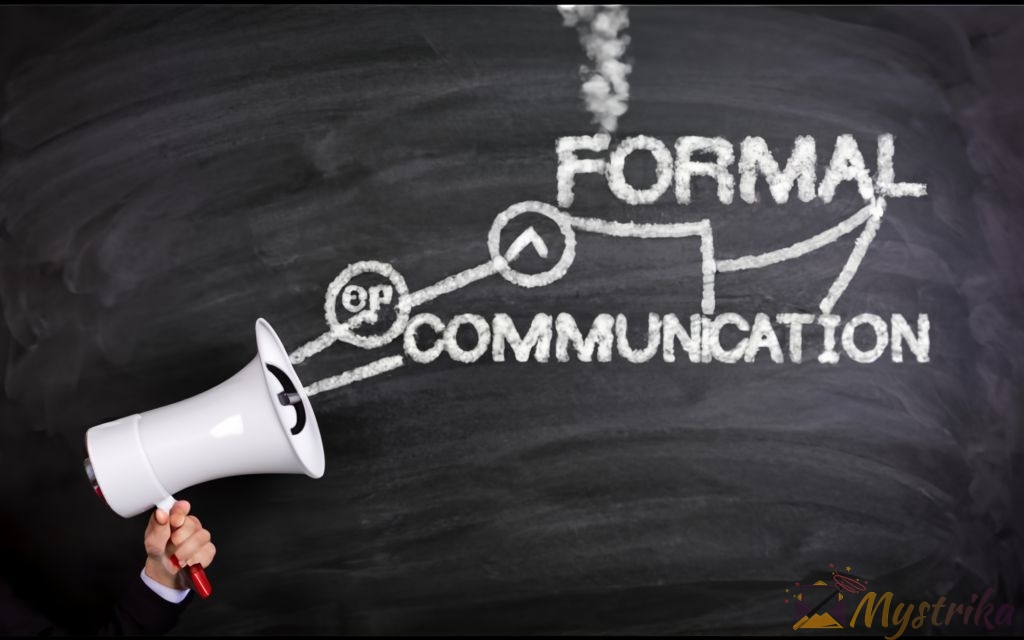Communicating professionally doesn’t have to be stiff and robotic. Learn how adapting your style for formal audiences and situations can build trust and credibility.
Understanding Formal vs Informal Communication
Communication comes in many forms. From quick text messages to formal business reports, the way we communicate depends greatly on the situation and audience. Understanding when formal communication is appropriate and how to use it effectively is a key skill for success.
Defining Formal Communication
Formal communication refers to any communication that follows specific rules, structure, and guidelines. It is communication that occurs in professional, academic, or official settings and adheres to formal language conventions.
Some key characteristics of formal communication are:
- Uses complete sentences and proper grammar
- Avoids slang, colloquialisms, and contractions
- Follows standard structure and organization
- Maintains professional, polite tone
- Focuses on facts and logic over emotions
- Avoids exaggeration and overstatement
Formal communication is often used for:
- Business reports, emails, presentations
- Academic writing and speaking
- Legal documents and proceedings
- Ceremonial addresses or speeches
Though formal communication must follow certain guidelines, it should not sound overly stiff or robotic. Skillful formal communication maintains clarity while still sounding natural.
Key Traits of Formal Communication
Formal communication utilizes several important traits:
Precise language: Formal communication avoids vague or generic language by using words that are specific and unambiguous. For example, instead of saying a product “improved”, a formal report would state specifically that “errors were reduced by 15%” or “sales increased by 20%.
Objectivity: Formal communication focuses on facts, data, and logic over personal opinions and feelings. Statements are kept balanced and neutral without strong displays of emotion.
Completeness: All necessary background information and details are included so the audience has everything they need to understand the message.
Clarity and concision: Messages are conveyed in a clear, easy to understand manner using as few words as possible. Verbose, convoluted language is avoided.
Politeness: Formal communication maintains polite language and avoids insults, criticism, or confrontational statements. Respect for the recipient’s position is shown.
Accuracy: All information and data contained in the communication is verified to be correct. Sources are cited where applicable.
Organization: There is a clear structure and logical order to formal communications based on the purpose and goals.
By keeping formal communications concise, objective, and accurate, senders can build trust and authority with recipients.
When is Formal Communication Appropriate?
Formal communication is appropriate in any situation where professionalism and objectivity matter. This includes:
Business settings: Communications with colleagues, management, clients, partners, and other stakeholders, such as:
- Proposals, reports, and presentations
- Policy announcements
- Project documentation
- Contracts, transactional emails
- Press releases
Academic environments: Student-teacher and student-administration communications, such as:
- Essays, dissertations, theses
- Classroom discussions
- Emails to professors/advisors
- Applications
Civic activities: Communications with government officials or as part of official civic processes like:
- Legal proceedings
- Public commentary periods
- Town halls
- Council meetings
Public addresses: Speeches, lectures, and talks in front of large audiences or to the public.
Ceremonial addresses: Eulogies, speeches at retirements/awards ceremonies, etc.
Any situation where the speaker is conveying information in an official capacity calls for formal communication.
Examples of Formal Communication Scenarios
To better understand formal communication in practice, let’s look at a few examples:
Business report: A manager prepares a quarterly budget report for the executives. The report would avoid personal opinions and slang, clearly present data using charts/tables, and follow standard business report format.
Press release: A company prepares a press release to announce a new product. The release uses objective language, industry-specific terminology, quotes reputable sources, and focuses on facts about the product’s benefits and features.
College lecture: A professor gives a lecture to students on a complex philosophical concept. The lecture uses academic language suited to the topic, structured outline of key points, and avoids tangents or subjective statements.
Courtroom argument: A lawyer presents their case before a judge and jury. The language is formal and procedures are precisely followed. Evidence is documented and rhetoric uses logic over emotion.
Ceremonial speech: A best man gives a speech at his friend’s wedding. Though the tone is warm, he maintains polite language and focuses on wishing the couple well over voicing private jokes or stories.
In each scenario, the communication adheres to formal standards rather than casual, conversational norms. Following formal communication principles helps establish professionalism and trust when clarity and precision are vital. With some practice, formal communications can become second nature.
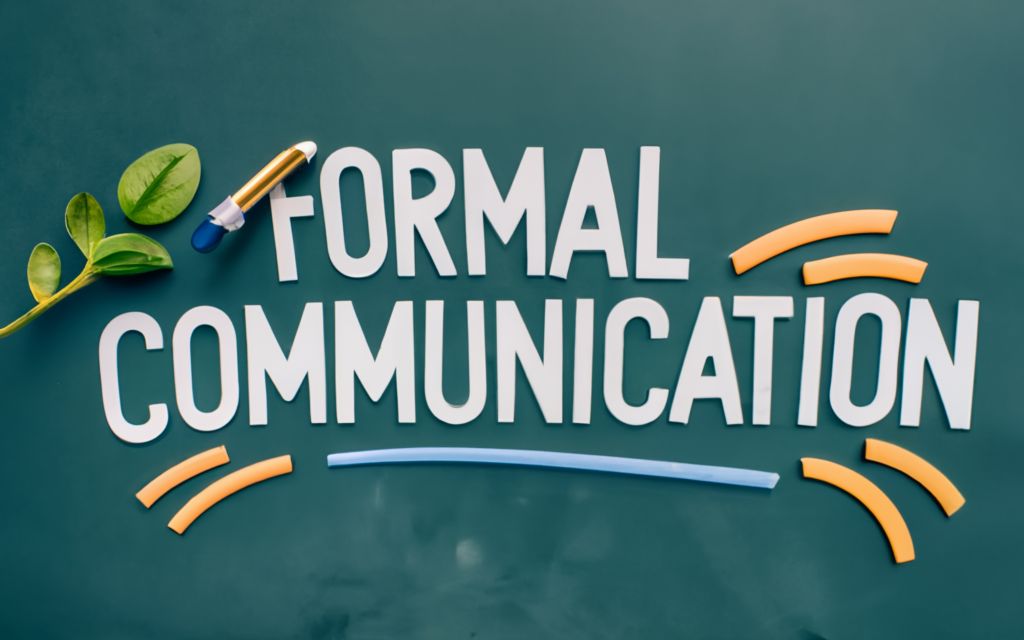
Adapting Your Approach for Formal Audiences
When communicating to formal audiences, it’s important to adapt your approach to align with their expectations. Conducting audience analysis, tailoring your content, and choosing the right medium can help you make a professional impression.
Conducting Audience Analysis
The first step is getting to know your audience through audience analysis. This allows you to tailor your communication style and content to their needs.
There are two main types of audience analysis:
Formal vs Informal Audience Analysis Methods
Formal analysis involves research into quantifiable details like demographics, psychographics, and preferences. For example, you may distribute surveys or consult sales data to identify audience attributes.
Informal analysis covers direct observations during interactions. This can include assessing nonverbal signals, questions asked, or feedback given to discern the audience’s knowledge, interest, and attitudes.
Using both approaches provides comprehensive insight into an audience for adapting communications appropriately.
Key Questions to Ask in Audience Analysis
Some key questions to consider when analyzing a formal audience:
- What is the audience’s field of work or industry? This affects their baseline knowledge and technical proficiency.
- What expectations might they have for communications in their field? Different industries have unique conventions.
- What communication style and tone might they be accustomed to? The audience’s role likely shapes preferences.
- How knowledgeable are they regarding the specific communication topic? Don’t assume expert-level familiarity.
- What objections or concerns might they have? Audiences analyze information critically.
- What questions might they ask? Anticipating inquiries can aid explanations.
- What outcomes does the audience hope to achieve? Communications should target desired goals.
Thorough audience analysis ensures you can craft communications tailored specifically to who you are addressing.
Tailoring Content for Formal Audiences
With audience analysis complete, you can shape content to best resonate with the intended recipients.
Using Proper Language and Style
Formal content requires proper language devoid of slang, idioms, colloquialisms, or conversational tone. Sentences should be grammatically correct and vocabulary should match the audience’s level of knowledge.
However, language shouldn’t become overly complex or arcane. Accessibility and clarity should be balanced with formality.
Removing Contractions, Slang, Abbreviations
Elements like contractions, slang, and abbreviations common in casual speech or writing should be avoided. For example:
- Use “cannot” instead of “can’t”
- Use “regarding” rather than “about”
- Spell out abbreviations instead of using acronyms
This promotes proper style. But don’t take it to an extreme where language sounds utterly foreign.
Avoiding Humor, Sarcasm, Exaggeration
Elements that work well for entertaining should also be avoided, including:
- Humor or jokes
- Sarcasm or irony
- Exaggerated descriptions
While these can backfire even in casual communications, they are too risky for formal messages where building credibility is key.
Using Complete, Grammatically Correct Sentences
Formal communications should contain:
- Complete sentences with a subject and predicate.
- Correct grammar with proper syntax and agreement.
- Correct punctuation following standard conventions.
Well-constructed sentences project an educated, meticulous tone.
Formatting like bullet points or numbered lists can increase scannability for long content. But avoid sentence fragments.
Structuring Content Appropriately
Formal communications must follow logical organization schemes suited to the content type and purpose.
Following Logical Progression of Ideas
All ideas should flow in an order that makes sense based on their interrelations and dependencies. Common structures include:
- Chronological: Ideas follow a timeline sequence.
- Spatial: Content relates to physical or virtual locations.
- Causal: Ideas build upon each other through cause and effect.
- Problem/solution: A problem scenario is explained and then solved.
- Argumentative: Points provide evidence leading to a main argument or claim.
Using transitions and overview statements can further connect ideas for clarity.
Using Headings, Bulleted Lists, Other Formats
Visual formatting elements like headings, lists, and tables should be used to organize long or complex content:
- Headings: Guide sections and hierarchy of ideas.
- Numbered lists: Arrange procedural steps.
- Bulleted lists: Break down components of larger concepts.
- Tables/charts: Display quantitative data clearly.
But use these judiciously. Avoid short, disconnected passages.
Choosing Appropriate Medium and Delivery
The medium used to deliver a message also requires adaptation to suit formal recipients.
Written communications allow conveying complex details precisely using proper formatting and language. Reports, emails, or published materials reach audiences asynchronously.
Verbal communications like presentations or speeches let you connect directly through tone and nonverbal cues. Visual aids can enhance clarity.
Visual communications including charts, diagrams, or infographics integrate text and images for clear explanations of relationships, hierarchies, or processes.
Mixed media combines written, verbal, visual, and even auditory elements for multidimensional communications like videos, webinars, or in-person interactions.
Consider the audience’s preferences, conventions in their industry, and communication purpose when selecting media and delivery methods.
By taking an audience-centered approach, formal communications can engage recipients and accomplish objectives while upholding critical perception of expertise and professionalism.
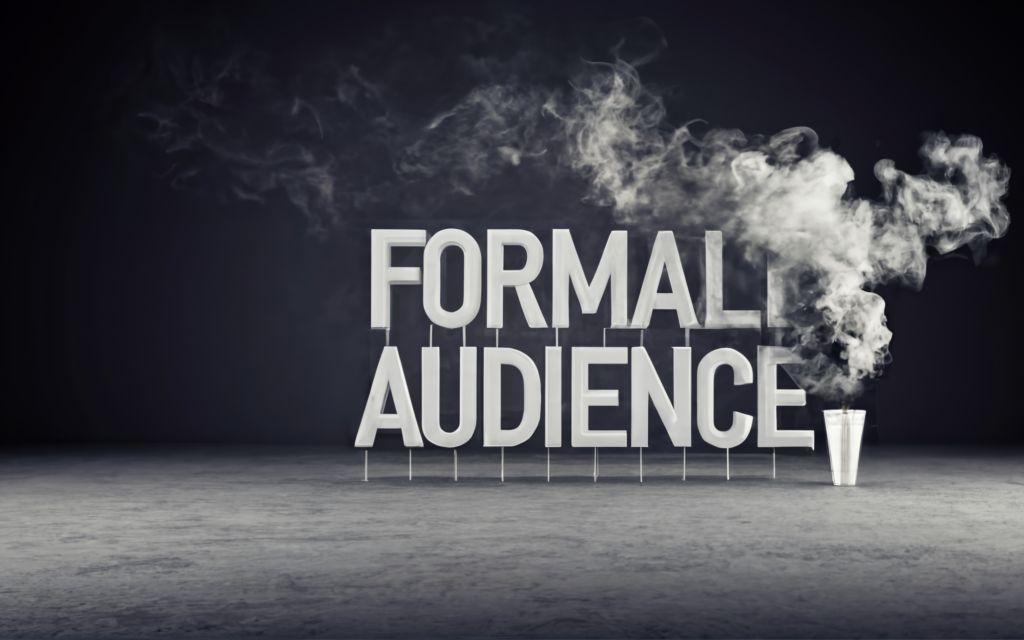
Crafting Formal Written Communications
Two of the most common types of formal written communications are emails and reports/documents. Each has standard conventions to follow.
Writing Formal Emails
Email allows efficient communication, but also risks coming across as too casual. Applying a formal style promotes professionalism.
Structuring a Formal Email
A formal email should contain:
- Subject line: Concisely states the email’s purpose.
- Salutation: Appropriately addresses the recipient.
- Introduction: Opens by establishing context and stating the communication’s purpose.
- Body: Elaborates on key details, provides information, or makes requests using complete, grammatical sentences.
- Conclusion: Summarizes next steps or follow-up actions.
- Closing: Ends politely with signature containing contact information.
Greeting Recipient Appropriately
The salutation should address the recipient in a polished, professional manner:
- “Dear Mr./Ms. [Surname]” for formal unfamiliar recipients
- “Hello [First Name]” for less formal familiar recipients
- Group recipients as “Dear [Group Name]”
Don’t use casual phrases like “Hi guys” or “Hey there”.
Stating Purpose Clearly in Opening
Concisely explain the email’s purpose and context in the first paragraph or sentence:
- “I am writing regarding the Q3 budget report…”
- “Per our discussion yesterday, please find the meeting agenda attached.”
This introduction provides direction for the recipient.
Maintaining Formal Tone Throughout
The entire email body should use formal language and style:
- Construct complete, grammatical sentences
- Avoid contractions, abbreviations, slang
- Use formal vocabulary suited to the topic
- Maintain polite, professional tone
Avoid becoming too informal, humorous, or conversational even when familiar with the recipient.
Closing Politely With Next Steps
Wrap up a formal email with:
- A sentence recapping main points or summarizing next steps.
- A polite closing like “Best regards” or “Sincerely”.
- Your name and contact information in the signature.
End positively while projecting professionalism.
Creating Formal Reports and Documents
Reports, proposals, and other professional documents also require formality.
Using Standard Report Format and Structure
Follow expected formatting for the document type:
- Title page: Contains report name, author, date.
- Executive summary: Highlights key facts and takeaways.
- Table of contents: Lists section headers and page numbers.
- Introduction: Establishes context and goals.
- Body: Provides background, requirements, methodology, results, etc.
- Conclusion: Recaps findings and implications.
- References/appendices: Cites sources, provides supplemental materials.
Removing Contractions, Colloquialisms
As with emails, avoid contractions, idioms, and informal language. Use proper vocabulary suited to the subject matter.
Sticking to Facts and Objectivity
Formal documents should remain objective and impartial. Exclude personal opinions, exaggerations, or biased interpretations. Use evidence-based statements backed by research.
Applying these guidelines helps reports and documents align with audience expectations for clear, accurate communications that uphold credibility.
Delivering Impactful Formal Presentations
From conference talks to boardroom pitches, formal speeches and presentations require adapting your verbal delivery and use of visual aids to maintain professionalism.
Adapting Verbal Delivery Style
When presenting formally, your vocal delivery style must align with audience expectations.
Enunciating Clearly, Avoiding Vocal Fillers
It’s important to:
- Enunciate words fully without mumbling or trailing off.
- Avoid fillers like “um”, “uh”, “like”, etc. Pause instead.
- Regulate volume to ensure you can be heard. But avoid shouting.
- Vary tone and inflection to add emphasis rather than speaking monotone.
These techniques keep the audience engaged and project competence.
Speaking Confidently With Appropriate Pace/Tone
Additionally:
- Maintain steady pace and rhythm. Don’t rush through or drag slowly.
- Use an authoritative, professional tone. Avoid seeming unsure or overly casual.
- Make appropriate eye contact. Scan the whole audience.
Confidence and command of the room builds credibility with formal audiences.
Using Visual Aids Effectively
Visual aids like PowerPoints enhance verbal presentations when used properly.
Designing Simple, Professional Visuals
Visual aids should have:
- Legible fonts and large text so content is readable from a distance.
- High contrast between text and background colors.
- Professional design aligned with your brand.
- No excessive text, animation, or graphics. Avoid visual clutter.
Well-designed visuals promote information retention in formal settings.
Displaying Only Pertinent Information
Visuals should complement your talk rather than regurgitate it.
- Avoid lengthy text passages. Use concise bullet points instead.
- Show data visually through graphs, charts, diagrams.
- Use images judiciously to illustrate concepts.
Cite sources for any data, facts, or images from external references to uphold diligence.
Handling Q&A Sessions Smoothly
Many presentations have a Q&A portion, requiring skill to handle inquiries smoothly:
- Listen carefully to entire questions before responding to avoid misinterpretations.
- Answer politely and factually. Don’t get defensive or use questions to soapbox opinions.
- Concisely explain complex topics using digestible language for broad audiences.
- Admit if you don’t know the answer. Offer to follow up with more research.
- Bring conversations back on track if questions become tangential.
Professional Q&A sessions build rapport with audiences and reinforce expertise.
In summary, from speech patterns to visual aid design to engaging inquiries, mastering formal presentation delivery makes communications more polished, persuasive, and impactful for intended audiences.
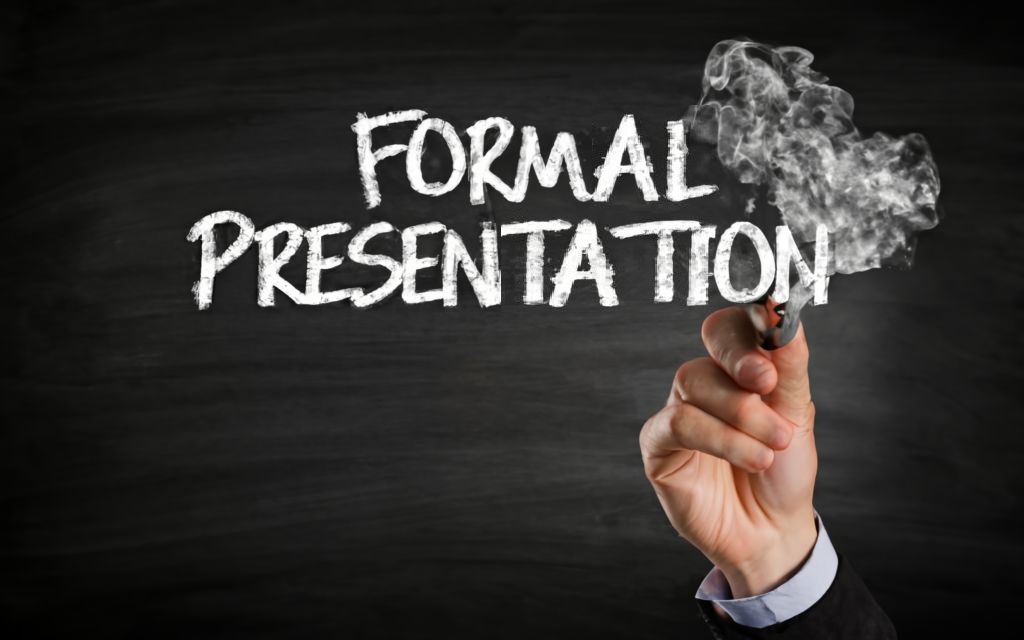
Ensuring Clarity and Professionalism
Crafting polished, formal communications requires effort. But the impact is worth the investment. Follow these tips to ensure your communications are clear and professional.
Proofreading Thoroughly
Before finalizing any important communication, meticulous proofreading is essential:
- Check for spelling/grammar errors. Use tools like spellcheckers to catch mistakes.
- Verify facts, statistics, and data points. Ensure accuracy to maintain credibility.
- Review formatting and style consistency. Headings, lists, and document elements should follow conventions.
- Assess readability. Use the Flesch-Kincaid scale to grade complexity. Simplify dense passages.
- Check for repetition. Remove redundant phrases or passages that restate ideas.
- Read aloud. Identify awkward phrasing by hearing the flow.
Thorough proofing often requires multiple passes focused on different aspects.
Practicing and Rehearsing Delivery
For presentations, practice delivery to refine it:
- Practice aloud and timed. Ensure content length is appropriate.
- Record practice runs. Review recordings to catch issues.
- Hold full dress rehearsals. Practice with visual aids in a presentation setting.
- Refine and adjust. Use feedback and self-review to modify and improve delivery.
Practice builds comfort, confidence, and command of the material when presenting.
Gathering Feedback from Trusted Sources
Sharing communications with trusted colleagues before finalizing can provide valuable input:
- Ask for constructive criticism. Welcome suggestions for improvement.
- Inquire about clarity. Check if the purpose and reasoning make sense.
- Request proofreading assistance. Extra eyes catch additional errors.
- Pose questions. Test interpretations and assumptions on others.
- Check for engagement. See if the content holds attention throughout.
Incorporate meaningful feedback to maximize the effectiveness of communications.
However, be wary of feedback that tries to push communications in a drastically different direction not aligned with goals, audience, or principles of formality.
Maintaining Consistency
Using templates and style guides promotes professional consistency:
- Create email templates with standard sections and formatting.
- Develop master presentations to use consistent branding.
- Maintain a style guide with conventions for documents and reports.
- Use macros and shortcuts to automate inserting common elements.
Defaults and templates reduce effort for frequently created communications.
Scheduling Adequate Time
Rushing critical communications inevitably compromises quality:
- Start early. Give time for researching, writing, proofing, practicing, and revising.
- Limit multitasking. Focus on one communication at a time.
- Avoid distractions. Silence phones and close distracting apps when writing.
- Take breaks. Walk away briefly when fatigued to maintain concentration.
Rushing results in sloppy errors and unclear logic. Planning ahead ensures you can fully develop professional, polished communications.
In summary, formal communications require diligence to craft. But properly executed, they convey expertise and command audience respect. Prioritizing clarity, accuracy, and professionalism makes communications more successful.
Key Takeaways and Conclusion
Crafting effective formal communications requires skill and effort. By following guidelines to adapt your approach, you can make a professional impression suited to formal audiences and situations.
Here are some key takeaways:
- Know your audience. Conduct analysis using surveys, observations, and research to understand their attributes, expectations, and preferences. This allows tailoring communications specifically for them.
- Use proper language and style. Formal communications should utilize complete sentences, standard grammar, industry-specific vocabulary, and avoid slang or informal language.
- Structure content logically. Organize ideas in a sensible sequence or hierarchy. Use formatting like headings, lists, and visual elements to aid comprehension.
- Choose the right medium. Match the communication format and delivery method to audience conventions and needs, whether written, verbal, or multi-media.
- Proofread extensively. Verify content is accurate, consistent, and error-free through thorough editing and review before finalizing.
- Practice delivery. Rehearse presentations and speeches to polish verbal and nonverbal delivery.
- Ask for feedback. Get input from trusted colleagues to identify potential areas of improvement.
- Allow adequate time. Rushing compromises quality. Build in time to research, write, review, practice, and refine.
With preparation and practice, formal communications can become second nature. The extra effort pays dividends in how audiences perceive your professionalism, expertise, and trustworthiness.
In conclusion, formal communications require adapting your approach to align with audience expectations for polish, precision, and objectivity. Avoid shortcuts or assumptions when preparing important communications. A meticulous, audience-centered process ensures maximum clarity and impact, building your reputation as an effective professional communicator.
The rewards of skillful formal communication are substantial. Formal communications convey knowledge and ideas accurately, persuade stakeholders, establish credibility, and ultimately help achieve business or organizational goals through informed actions. With determination to uphold standards, you can master formal communications and unlock their tremendous potential value.
Here are key takeaways for the entire article “How to Craft Formal Communications for Maximum Impact”:
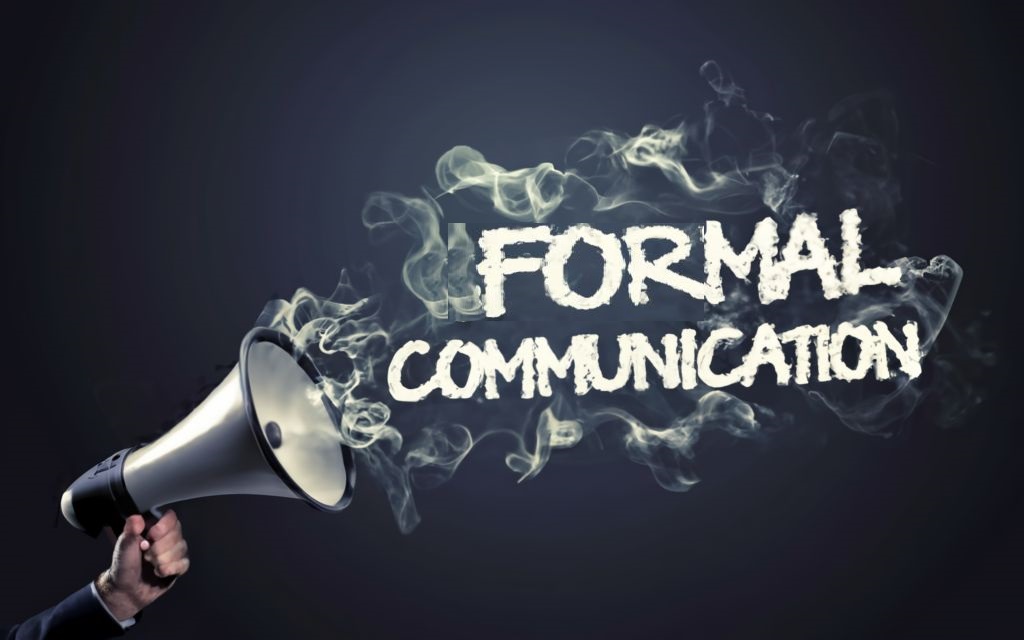
Key Takeaways
- Formal communication adheres to rules of proper grammar, structure, and style to convey information accurately and objectively.
- Informal communication uses conversational tone, slang, humor, and expresses opinions, suitable for casual contexts with friends or family.
- Audience analysis involves researching demographics and psychographics along with direct observations to understand an audience’s knowledge, attitudes, expectations, and preferences.
- Tailor content to formal audiences by using proper vocabulary and sentence structure, avoiding idioms, humor or exaggeration, and structuring logically.
- Proofread thoroughly to eliminate errors, verify facts, ensure readability, and assess clarity before finalizing formal communications.
- Practice delivering speeches and presentations to polish verbal and nonverbal delivery techniques for professional impact.
- Use visual aids judiciously, ensuring legibility and focusing on pertinent data to complement presentations.
- Plan adequate preparation time to research, write, review, practice, and refine formal communications for optimal quality.
- Ask trusted colleagues for feedback to get an outside perspective on areas of potential improvement.
- Maintain consistency by using templates and style guides to streamline creating frequent formal communications.
By diligently following guidelines and best practices for formal communications, you can craft messages that engage audiences and accomplish objectives in professional settings.
Here are some frequently asked questions about formal communication:
Frequently Asked Questions
Q: What are some examples of formal communication?
A: Examples of formal communication include business reports, press releases, legal documents, academic essays, professional emails, and speeches or presentations. Formal communication follows structured guidelines and conveys information accurately and objectively.
Q: When should I use formal vs. informal communication?
A: Use formal communication when addressing unfamiliar audiences, in professional or official settings, for permanent records, or when credibility and precision are vital. Use informal communication with family/friends, for casual contexts, or temporary messages. Assess audience and goals.
Q: How can I adapt my writing style to be more formal?
A: To make writing more formal, use complete sentences, proper grammar, industry-specific terms, and avoid idioms, slang, abbreviations, humor, or opinionated language. Also structure content using headings, lists, and other formatting to aid organization.
Q: What are some tips for delivering formal presentations?
A: Tips for formal speeches include avoiding verbal fillers, varying tone/pace, maintaining eye contact, designing simple/professional visual aids, displaying concise text/data, limiting graphics, and handling Q&A sessions by listening fully and answering politely and concisely.
Q: How much preparation time should be allocated to craft formal communications?
A: Quality formal communications require extensive preparation. Build in adequate time for conducting audience research, writing initial drafts, gathering feedback, proofreading/editing, fact-checking, practicing delivery, and final revisions. Avoid rushing.
Q: What types of feedback are most valuable when perfecting formal communications?
A: Most valuable feedback focuses on assessing clarity, organization, grammar/style errors, appropriate vocabulary level, parallel structure, concision, logical flaws, visual design, and consistency. Feedback prioritizing substantive delivery and style improvements is more useful than opinions on content.
Q: Why are templates and style guides useful when frequently producing formal communications?
A: Templates and style guides improve consistency and efficiency when producing recurring communications like reports, presentations, form letters, etc. Default formats reduce effort while upholding quality standards.

